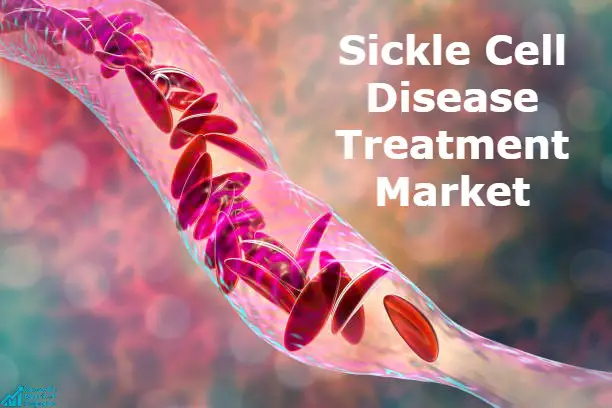The global sickle cell disease treatment market size was valued at 1.10 billion in 2020 and is anticipated to expand at a substantial CAGR during the forecast period, 2021–2028. The growth of the market is attributed to the increased immigration, improved healthcare, and the presence of a large population base of African origin.
Sickle cell disease (SCD) is a genetic blood illness marked by malformed, rigid, sickle-shaped red blood cells (RBCs) caused by beta-globin gene abnormalities. The severity of the condition differs greatly from one person to another. The most common treatments for persistent SCD are hydroxyurea and blood transfusions. In general, hydroxyurea intolerance affects a substantial proportion of people. However, patients who do not have hydroxyurea resistance have minimal advantages and long-term hazards linked with safety. Sickle cell disease is a set of diseases that impair hemoglobin, the molecule that transports oxygen throughout the body. A deformed red blood cell with the shape of a sickle or crescent is found in people with this condition. Symptoms of sickle cell disease commonly appear in early childhood and continue until adolescence. Red blood cells break down prematurely as they alter the shape, which can cause anemia. The goal of sickle cell anemia treatment is to alleviate discomfort, alleviate symptoms, and prevent complications. Some adolescents and teenagers are treated with medications and blood transfusions.
Based on distinct mutations in hemoglobin genes, sickle cell anemia can be bifurcated into phenotypic variances and genotypic variances. Approximately 300,000 newborns are diagnosed with sickle cell illness every year, and around 20 to 25 million people have inherited sickle cell features worldwide. It is observed that people of African, Middle Eastern, and South Asian heritage are more likely to have sickle cell disease. Blood-borne infections, allergic responses, iron overload, and fever are all risks for patients who get blood transfusions. About 20% of sickle cell disease patients need blood transfusions to survive. Bone marrow transplant (BMT) is the only possible curative treatment; however, it is suggested to a limited number of patients.
Until 2017, hydroxyurea, marketed by Addmedica and Bristol-Myers Squibb under the names Droxia, Sicklos, and Hydrea were some of the sole drugs that the US Food and Drugs Administration (FDA) approved and are medicines commercially available for the treatment of this illness. Endari, a drug developed by Emmaus Life Sciences, was the second-ever drug approved by the FDA in July 2017 for the treatment of severe complications associated with SCD in adults and children over the age of five.
The COVID-19 pandemic had a positive impact on a few industries while the others faced a negative impact; however, the global sickle disease treatment market faced a mixed impact. The donor base demand for blood supplies was compressed down by the sudden outbreak of pandemic. The imposition of lockdown and restrictions regarding travel caused a decline in the number of donors along with the cancellation of various drives for blood donation. As per the reports by United States Blood Centres, in 2019 approximately 250,000 blood donations were missed that led to a decline in blood drive schedules. Moreover, as per the reports by American Red Cross Blood Services, in March 2020 around 50,000 blood drive schedules were cancelled or moved. However, the situation was under control and got back on track by the end of 2020 due to the approval of new regulations.
Market Trends, Drivers, Restraints, and Opportunities
- Rising cases of sickle cell diseases across the globe along with the increasing immigration of population from Africa is expected to boost the market growth during the forecast period.
- Improvement in healthcare services and investment made for the treatment of sickle cell disease is projected to push the market growth during the forecast period.
- Lack of awareness among the population base coupled with the unavailability of drugs in rural areas across regions is expected to hamper the market growth.
- High cost of treatment and low healthcare expenditure in countries with low to medium economic growth are anticipated to impede the market growth.
- Growing research & development activities and investments made in them by the government and other several pharmaceutical companies is projected to present key opportunities for the market.
Key Players
- Emmaus Medical, Inc.
- Global Blood Therapeutics, Inc.
- bluebird bio, Inc.
- Pfizer, Inc.
- Novartis AG.
Competitive Landscape
Key players competing in the sickle cell disease treatment market are Emmaus Medical, Inc.; Global Blood Therapeutics, Inc.; bluebird bio, Inc.; Pfizer, Inc.; and Novartis AG. Emmaus Medical is expected to be the market leader in the coming years attributed to robust Endari sales, Followed by the approval and launch of their pipeline candidates, Altemia and voxelotor respectively, Global Blood Therapeutics and Sancilio have the potential to earn significant market share.
Drugs in the late stages of development such as Pfizer's rivipansel and Novartis' crizanlizumab have also shown promising results. Disruptive therapies such as Sevuparin from Modus Therapeutics and Sanguinate from Prolong Pharmaceuticals are expected to boost the industry. Gene therapies such as Bellicum Pharmaceutical's BPX 501, bluebird bio's Lentiglobin, and Gamida Cell's Cordin are expected to enter the sickle cell disease therapeutics market in the near future.
To Get a New Sample Request:
https://growthmarketreports.com/request-sample/1927
Contact Us
- Growth Market Reports
- Phone: +1 909 414 1393
- Email: sales@growthmarketreports.com
- Web: https://growthmarketreports.com






